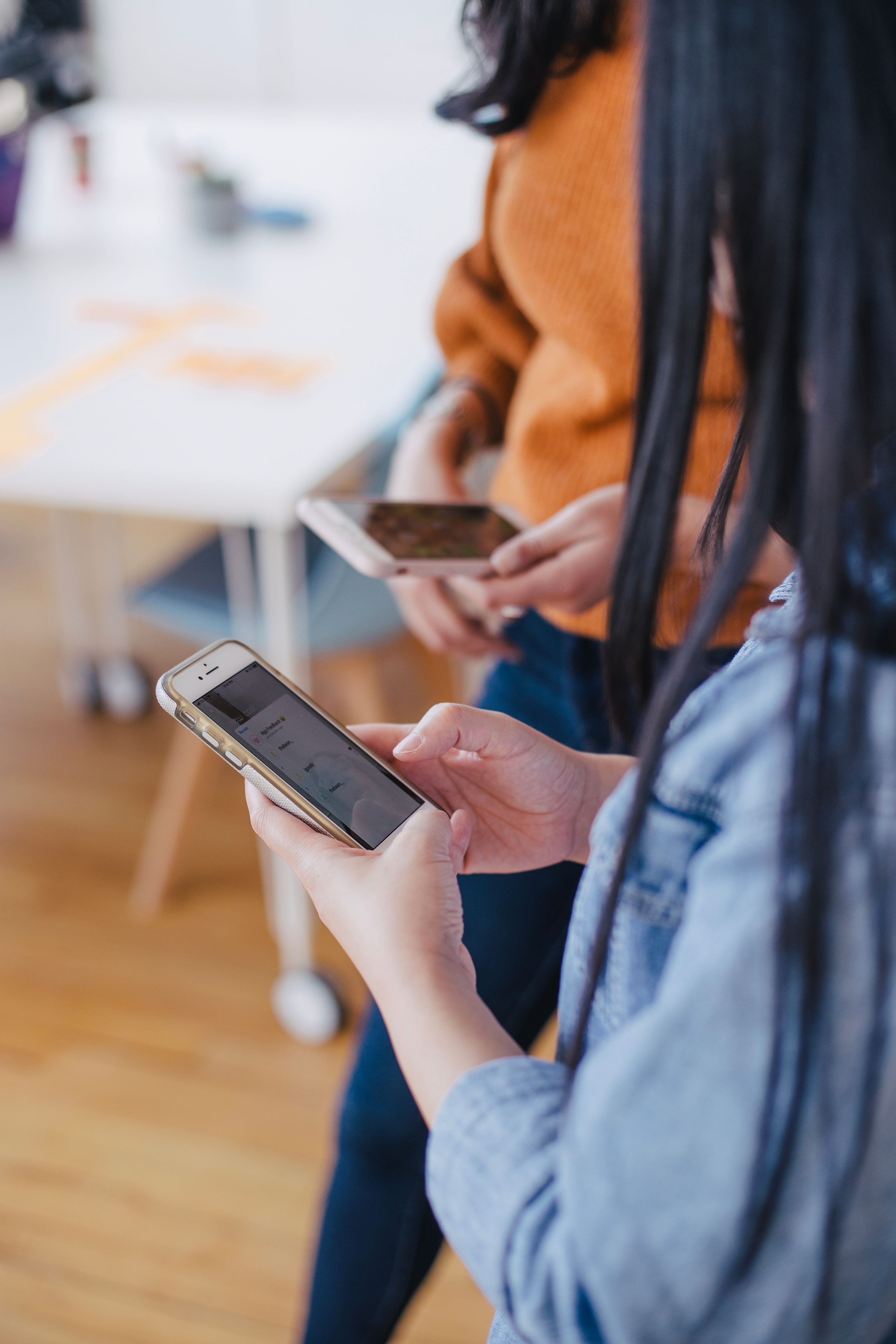 Have you ever noticed how much you pick up your phone throughout the day? I knew that I was reaching for my phone while waiting for the train, getting out of the shower, picking up takeout—all those little pockets of “down” time throughout the day—but I didn’t realize just how much time and energy my phone was sucking until I unplugged for a weekend.
Have you ever noticed how much you pick up your phone throughout the day? I knew that I was reaching for my phone while waiting for the train, getting out of the shower, picking up takeout—all those little pockets of “down” time throughout the day—but I didn’t realize just how much time and energy my phone was sucking until I unplugged for a weekend.
This sounds like a conspiracy theory, but it’s actually true: technology is designed to be addictive. Tech companies make money when we use their devices. Social media platforms make more ad revenue the more time we spend on their apps. These digital tools have been intentionally created to evoke long-term, near-constant use.
When you feel like you just can’t help but pick your phone up, or you can’t seem to stop scrolling, it’s not because you have no willpower. Tech and social media companies deliberately exploit weaknesses in human psychology to make us use our devices as often as possible. They do this by preying on our affinity for intermittent rewards.
Intermittent reinforcement has been well-supported in psychology as one of the most effective conditioning methods. Let’s take the example of training my German Shephard. If I were to tell him to “come” with a treat in my hand every single time, he would come most of the time (but surprisingly, not always!). If I were to I tell him to “come” and never give him a treat for it, he would barely follow the command. If, however, I give him a treat only some of the time I tell him to “come,” he obeys every single time. This is the principle of intermittent rewarding. It turns out that offering rewards some of the time, not all of the time and not none of the time, is most effective in controlling behavior.
Intermittent reinforcement is exactly how our phones work. We get updates: texts, likes, comments, repins, emails, etc. only some of the time. So we check our phones all of the time. If we were to never get any updates, checking our phones probably wouldn’t be very fruitful, so we would stop. Likewise, if every single time we picked up our phones we were bombarded with notifications, we would become desensitized. By offering intermittent notifications, our devices take advantage of human psychology to compel us to pick our phones up again and again. There are other activities that can be explained by intermittent reinforcement—gambling, for instance.

So now that you know why our phones are so darn addictive—how do you break the cycle? I took a jump start last weekend by embarking on a digital detox. I went to my grandmother’s apartment and intentionally left my phone and computer behind for the entire weekend. I was lucky to have somewhere to go in a different physical location than my devices, but you can make this work in your own home too by turning off and shutting away your devices where you can’t see them. If you’d like the added benefit of a different location, see if you can visit friends or relatives or even rent an Airbnb.
During my digital detox, I did a lot of reading, drawing, meditating, and just plain hanging out. I realized that it had been a while since I really gave myself space to just sit with myself outside of my daily 10-minute meditation practice. I tend to grab for my phone whenever I’m feeling restless or sense even the smallest pocket of time. I didn’t even realize how much I reach for my phone until I didn’t have it with me! Even though it was a little less than 48 hours, my digital detox was incredibly eye-opening to how addictive my phone truly is. Here are a few things I noticed:
- I became painfully aware of when I would have reached for my phone, because I felt an urge to check it in between conversations with my grandma, after reading a chapter in my book, when finishing up a drawing, and it wasn’t there. It honestly scared me how much I wanted to reach for my phone throughout the day, and the fact that I wasn’t even aware just how much I used it until its absence.
- I walked to a restaurant for takeout, and sat and waited rather than going on my phone. I waited about 15 minutes for my food, and was fully aware that I would have spent the entire 15 minutes scrolling through Instagram had my phone been there.
- I walked around without a podcast or a friend’s voice in my ears. Whenever I’m walking somewhere, I nearly always either have a podcast playing or call a friend. Without my phone, I found myself listening to snippets of conversation and even some more subtle sounds like the wind moving through the trees, and it felt quite peaceful.
- I read over 300 pages of my book, took a nap, completed 3 mandala drawings, and got to bed by 10. Perhaps the best part of leaving my phone at home was realizing how much time I have for everything I want to do. I was lucky to dedicate a day to do whatever leisure activities I wanted, but this concept is important whether you have work, school, or other obligations—maybe even more so. I sometimes get screen reports from Apple that I’ve spent anywhere from 2-3 hours on my phone per day (ouch!) 10 minutes here, 15 there—it all adds up. Decreasing your technology time will make space for the activities you love and can also improve your sleep!
If you haven’t yet tried a phone-free weekend, I’d highly recommend it. We can’t all leave our phones all the time though. Here’s how I’ve been taking a conscious step toward decreasing my technology use since the digital detox:
- I deleted all social media apps off my phone. This might seem extreme to some, and I’ll probably eventually add some back, but so far it’s felt really really good. Social media apps are a big part of the intermittent reinforcement discussed above that makes our phones so addictive, and it’s been really great to look at my phone without feeling the need to click on five different apps. If I want to use any social media, I can use it on the computer.
- I turned off notifications for text messages.This has made a noticeable different for me. I realized that I was wasting so much time during the day texting and picking up my phone to see who texted back, and it was stressing me out. Turning off text notifications has allowed me to check my texts on my terms (which I now do several times per day instead of the standard near-constant checking) and it’s honestly so freeing. Social media and texting make up the majority of my phone notifications, so it’s been such a relief to find my phone blissfully notification-free (again going back to intermittent reinforcement – I’m breaking that cycle!).
- I manually logged out of iMessaging on my computer. I’ve realized that texting on my computer is also a huge time suck for me. It interrupts my workflow, stresses me out, and distracts me. Since logging out of messages, I’ve been able to focus more on my work.
- I’m reading the book Digital Minimalism by Cal Newport. I’m about halfway through, and I would highly recommend this book. It’s all about how and why technology is so addictive (touching on some of the principles we’ve talked about in this article and more!) and the author prescribes a 30-day “digital declutter” that involves giving up optional technologies for a month. I’m currently embarking on my digital declutter now, and I’m excited to see where it takes me. The book has so many great strategies and is a must-read if you’re interested in reducing your technology use.
I’m curious: do you see your technology use as a problem? Are you actively taking steps to reduce it, or would you like to? Comment below!
Also by Maille: Drained By The 9 To 5? Restore Your Wellness At Work With These 8 Essential Tips
These 5 Scientific Benefits Of Reading Will Make You Want to Curl Up, STAT
Get more like this—Subscribe to our daily inspirational newsletter for exclusive content!
__
Photo: Maille O’Donnell




